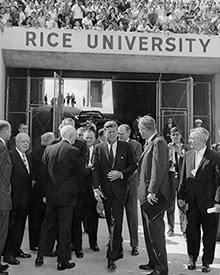
Thanks to the reputation of Rice University faculty researchers (and the canny political maneuvering of two former Rice roommates), “Houston” became the first word broadcast from the surface of the moon.
Rice University began its first research collaborations with NASA in 1959, just months after the agency was founded, but starting as early as 1958, Rice alumnus and board chairman George R. Brown ’20 was already hard at work behind the scenes, trying to make sure that Houston and Rice would play leading roles in the race for space. In 1961, thanks in large part to Brown and his friend and former Rice roommate, Congressman Albert Thomas ’20, Houston’s transformation to “Space City USA” officially began when the city was named the site of the NASA Manned Spacecraft Center (now Johnson Space Center).
Our decision is that this laboratory should be located in Houston, Texas, in close association with Rice University and the other educational institutions there and in that region.
Memorandum to President Kennedy from NASA Administrator James Webb Sept. 14, 1961

On Sept. 12, 1962, as part of Rice’s semicentennial celebrations, then president John F. Kennedy spoke at Rice Stadium, challenging the United States to become “the world’s greatest space-faring nation.”
In direct response to President Kennedy’s speech at Rice, the university established the nation’s first dedicated space science department in 1963.
On July 20, 1969, Apollo 11 astronauts Neil Armstrong and Buzz Aldrin became the first humans to walk on the moon. On that historic mission, they carried with them a lunar dust detector experiment designed by Rice professor Brian O’Brien.
On a later Apollo mission, NASA astronauts carried to the moon a larger self-contained ion detection experiment built by Rice professor John Freeman. That apparatus remains on the lunar surface to this day and, hidden inside its heat shield, the proud Rice researcher who built it placed a tiny university pennant to jokingly “claim” this small part of the moon for Rice.
The Rice Stuff

In recognition of Rice’s long history of close collaboration with NASA, and its role in President John F. Kennedy’s historic 1962 Rice Stadium speech, the Kennedy family has entrusted to Rice the NASA Ambassador of Exploration Award which was awarded posthumously to President Kennedy on the 40th anniversary of the Apollo 11 moon landing. The award displays an actual moon rock, and is on view in Rice’s Fondren Library.
We meet at a college noted for knowledge, in a city noted for progress, in a state noted for strength, and we stand in need of all three, for…the exploration of space will go ahead, whether we join in it or not, and it is one of the great adventures of all time, and no nation which expects to be the leader of other nations can expect to stay behind in the race for space.
President John F. Kennedy Rice University Sept. 12, 1962
For additional information on Rice's past and present NASA collaborations, please visit this recently updated Rice News story. When in Houston, be sure to visit the Rice Stuff exhibit in Rice’s Fondren Library. In addition, at Rice Stadium, a plaque commemorating president Kennedy’s 1962 speech may be seen, along with a next generation moon tree, cloned from a seed that flew to the moon aboard Apollo 14.
